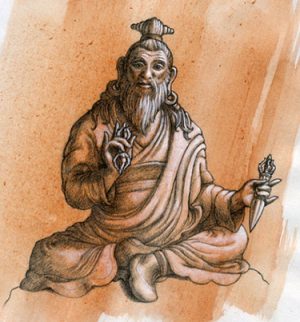THE GREAT PERFECTION

When such people with stable minds—without being boastful about the mere number of months or years they have spent practicing in retreat—see this entrance and undertake the practice, they will definitely achieve the supreme state of Buddha Vajradhara in this very lifetime. Of this there is no doubt.
— The Vajra Essence, Düdjom Lingpa’s Visions of the Great Perfection, Vol. 3
The pinnacle of nine successive spiritual vehicles
The view, meditation, and conduct of the Great Perfection (Dzogchen) are regarded in the Nyingma tradition of Tibetan Buddhism as the pinnacle of Buddhist theory and practice. According to this tradition, there are nine successive “yanas,” or spiritual vehicles, by which one can achieve enlightenment, ranging from one’s individual liberation, as taught in the Pali canon of the Buddha’s teachings, to the enlightenment of a buddha for the sake of all sentient beings, as taught in the Mahayana and Vajrayana schools of Buddhism. The Great Perfection is the ninth of these spiritual vehicles, presented as the culmination of Vajrayana Buddhism
Buddha nature
The central theme of the Great Perfection is the realization of one’s own buddha nature, which is first presented in the Mahayana teachings of Shakyamuni Buddha’s Third Turning of the Wheel of Dharma. While his Second Turning of the Wheel of Dharma, with its core teachings on the Perfection of Wisdom, illuminates the “objective clear light,” that is, the emptiness of inherent nature of all phenomena, the teachings of his Third Turning of the Wheel focus on the “subjective clear light.” This entails a realization of the all-pervasive nature of the omniscient mind of all buddhas, the indivisibility of one’s own mind-stream and this transcendent consciousness, and one’s potential to realize the perfect enlightenment of a buddha.
View
Insight into the view of the Great Perfection leads one to experientially identify the ultimate ground-state of one’s own awareness, variously known as pristine awareness, primordial consciousness, and buddha nature. By cutting through one’s conditioned, individuated stream of consciousness to this divine, unborn, unceasing dimension of consciousness that transcends all conceptual constructs and categories, one views the whole of reality from this perspective. With this view, one nondually realizes the emptiness of inherent nature of the whole of samsara and nirvana, and simultaneously perceives all phenomena as spontaneously manifesting displays of the transcendent ground of being—this primordial consciousness.
Meditation
The Great Perfection of meditation entails nothing more than a continual and effortless abiding in the view. This is done by first identifying one’s own pristine awareness and then resting there, de-activating all activities of one’s ordinary body, speech, and mind. Through such existential stilling of one’s activities as a sentient being, all the qualities of the mind of all buddhas spontaneously manifest, as one recognizes one’s true identity, which has always been that of a buddha.
Conduct
In the Great Perfection of conduct one continues to rest in the primordial stillness and purity of pristine awareness while going about one’s daily activities. Virtue arises spontaneously, flowing forth unimpededly from one’s divine ground. While sustaining nondual realization of the empty and luminous nature of awareness, unconditional, all-pervasive compassion for all beings arises spontaneously and manifests in ongoing expressions of the wisdom, compassion, and creative energy of a buddha.
A path to rainbow body
This thoroughly integrated triad of view, meditation, and conduct is widely regarded in Nyingma tradition as the simplest, most direct and powerful path to realizing perfect enlightenment. This path culminates in the achievement of an indestructible “rainbow body” of infinitesimally subtle light in this very lifetime, such that all vestiges of one’s body, speech, and mind as a sentient being dissolve into the divine ground. From then onwards, for as long as space and sentient beings remain, one continues to manifest in countless ways, leading all beings to their own Great Perfection.
What if … ?
What if, through the diligent practice of a few dozen utterly committed contemplatives, who have devoted their lives to meditating in retreat, even a few were to attain the most sublime realizations promised by the teachings on the Great Perfection? How might that change our world?
Catalyzing a contemplative renaissance
The contemplatives at the Centers for Contemplative Research set out with a simple and audacious goal: to practice until we reach the depths of the teachings on the all-encompassing Great Perfection, and to discover what they mean from within. Then, who knows what may burgeon forth as a true renaissance in contemplative practice, catalyzing a global understanding that provides us with the necessary framework for true and effective change?
In the lineage of Düdjom Lingpa
The specific lineage of the Great Perfection that is emphasized in our Centers for Contemplative Research stems from the renowned 19th-century Dzogchen master Düdjom Lingpa. It is said that thirteen of his disciples achieved a rainbow body, and many others gained direct realization of pristine awareness. The direct, unelaborated path that he revealed is rooted in the achievement of stable, clear concentration through the attainment of definitive shamatha, realization of emptiness through the practice of vipashyana, identification of pristine awareness through the practicing of cutting through, and the full manifestation of all the qualities of enlightenment through the practice of direct crossing over. It is our resolve to create the optimal opportunities for those training in our Centers to follow this sublime path to its culmination.
Never doubt that a small group of thoughtful, committed, citizens can change the world. Indeed, it is the only thing that ever has.
— Margaret Mead
